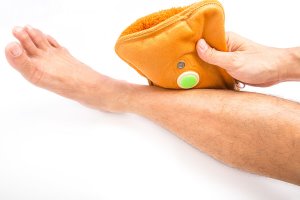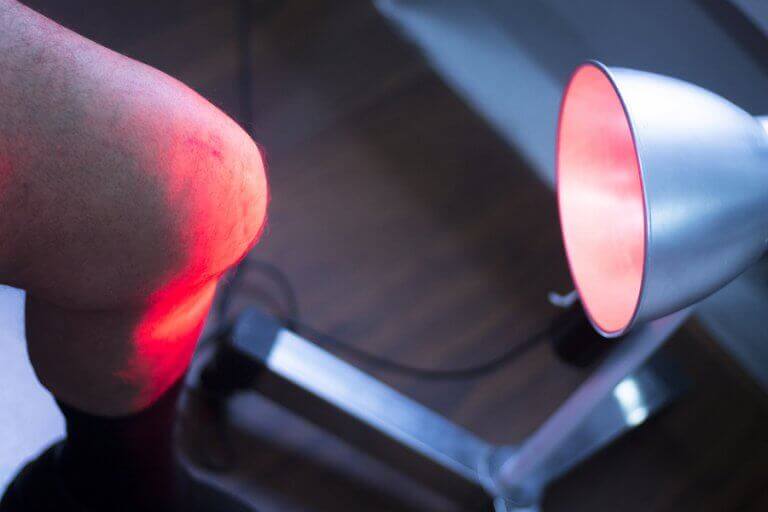Heat or Cold: Mechanisms and Applications for Injuries

Applying heat or cold over an injured or fatigued area after working out is an essential step. All kinds of patients or athletes can enjoy the benefits on a daily basis. Let’s take a look at their mechanisms of action and the cases in which they’re the most useful.
The mechanism of applying cold
As you would expect, cold has healing benefits because it lowers the temperature of the area. This decrease leads to the constriction of blood vessels and lower amounts of blood in the area as a result.
On top of this, cold can slow down the metabolism and the action of sensitive nerves. It can have other effects on different elements of the nervous system, such as increased sensibility in the area. Depending on if you apply it to superficial or deep muscles, it can either increase or diminish the contraction speed.
You also have to keep in mind that when you stop applying cold, a rebound effect happens. The body will compensate by increasing the blood flow to a cooled area when the stimulus goes away. It does this to prevent tissue damage and ensure that enough blood reaches the area.
How heat works in the body
On the contrary, the main effect of heat will be vasodilation. Causing an increase in the body temperature leads to an increase in the blood flow of the area. Therefore, all of the blood elements that help to repair damaged tissue also increase. On top of that, vasodilation helps to reduce the blood pressure.
Applying heat for long periods of time will also promote relaxation of the area, with antispasmodic effects and a decrease of sensibility due to the relaxation.
Finally, keep in mind that depending on the duration of the sessions and the temperatures that you reach, it can also increase your heart rate so that more blood reaches the area. In extreme cases, it can cause tachycardias. Because of this, people with heart problems should be especially careful.

Heat or cold?
With all of this in mind, when is one application of treatment better than the other? As a general rule, cold is useful in acute processes, while heat is the better alternative for chronic processes.
This means that if you’ve just suffered an injury, applying cold will contain the increased blood flow and help maintain a proportionate reaction in your body. It will also reduce the swelling caused by the rupture of tissues and help you tolerate the pain better.
Also, if you’ve just finished an intense exercise session, applying cold over the muscles that you worked the most will help to prevent the side effects and limit the damaged caused to your muscles.
On the contrary, heat will be a great ally in longer processes. It would be convenient to apply heat locally after 24 hours of the first signs of muscle pain.
As we’ve explained above, once you control the initial inflammation, increased blood flow can provide more blood elements that help the damaged tissue to recover. And, its antispasmodic effect will also make it a vital tool to treat muscle contractions or general built-up tension.
Application methods for heat and cold
For cold, the following methods of application are available:
- Ice cubes: in this case, you should always wrap them in a towel, cloth or similar material, since they shouldn’t come in direct contact with the skin.
- Cold packs: they come in different formats that you can cool down and apply to the desired area. You can also use cold towels or compresses.
- Cold creams or sprays: they offer a fast and temporary effect.
- Cryomassage: it consists of massaging the affected area with a few ice cubes wrapped in a towel, instead of just applying the ice and letting it work.

To apply heat, some of the tools you can use are:
- Heating pad: the classic heating pad we all have at home. You can pop it in the microwave and apply it over the desired area.
- Immersion: submerging the affected area in a hot water bath will help the heat reach deeper in your body.
- Infrared beams: if we go to a physical therapist, they may apply heat through infrared rays.
- Creams or sprays: similar to cold, we can buy creams or sprays that offer an immediate effect.
Finally, you also have the alternative of using massages. When someone gives you a massage, your body temperature increases. The greater the massage pressure is, the higher the temperature.
Applying heat or cold over an injured or fatigued area after working out is an essential step. All kinds of patients or athletes can enjoy the benefits on a daily basis. Let’s take a look at their mechanisms of action and the cases in which they’re the most useful.
The mechanism of applying cold
As you would expect, cold has healing benefits because it lowers the temperature of the area. This decrease leads to the constriction of blood vessels and lower amounts of blood in the area as a result.
On top of this, cold can slow down the metabolism and the action of sensitive nerves. It can have other effects on different elements of the nervous system, such as increased sensibility in the area. Depending on if you apply it to superficial or deep muscles, it can either increase or diminish the contraction speed.
You also have to keep in mind that when you stop applying cold, a rebound effect happens. The body will compensate by increasing the blood flow to a cooled area when the stimulus goes away. It does this to prevent tissue damage and ensure that enough blood reaches the area.
How heat works in the body
On the contrary, the main effect of heat will be vasodilation. Causing an increase in the body temperature leads to an increase in the blood flow of the area. Therefore, all of the blood elements that help to repair damaged tissue also increase. On top of that, vasodilation helps to reduce the blood pressure.
Applying heat for long periods of time will also promote relaxation of the area, with antispasmodic effects and a decrease of sensibility due to the relaxation.
Finally, keep in mind that depending on the duration of the sessions and the temperatures that you reach, it can also increase your heart rate so that more blood reaches the area. In extreme cases, it can cause tachycardias. Because of this, people with heart problems should be especially careful.

Heat or cold?
With all of this in mind, when is one application of treatment better than the other? As a general rule, cold is useful in acute processes, while heat is the better alternative for chronic processes.
This means that if you’ve just suffered an injury, applying cold will contain the increased blood flow and help maintain a proportionate reaction in your body. It will also reduce the swelling caused by the rupture of tissues and help you tolerate the pain better.
Also, if you’ve just finished an intense exercise session, applying cold over the muscles that you worked the most will help to prevent the side effects and limit the damaged caused to your muscles.
On the contrary, heat will be a great ally in longer processes. It would be convenient to apply heat locally after 24 hours of the first signs of muscle pain.
As we’ve explained above, once you control the initial inflammation, increased blood flow can provide more blood elements that help the damaged tissue to recover. And, its antispasmodic effect will also make it a vital tool to treat muscle contractions or general built-up tension.
Application methods for heat and cold
For cold, the following methods of application are available:
- Ice cubes: in this case, you should always wrap them in a towel, cloth or similar material, since they shouldn’t come in direct contact with the skin.
- Cold packs: they come in different formats that you can cool down and apply to the desired area. You can also use cold towels or compresses.
- Cold creams or sprays: they offer a fast and temporary effect.
- Cryomassage: it consists of massaging the affected area with a few ice cubes wrapped in a towel, instead of just applying the ice and letting it work.

To apply heat, some of the tools you can use are:
- Heating pad: the classic heating pad we all have at home. You can pop it in the microwave and apply it over the desired area.
- Immersion: submerging the affected area in a hot water bath will help the heat reach deeper in your body.
- Infrared beams: if we go to a physical therapist, they may apply heat through infrared rays.
- Creams or sprays: similar to cold, we can buy creams or sprays that offer an immediate effect.
Finally, you also have the alternative of using massages. When someone gives you a massage, your body temperature increases. The greater the massage pressure is, the higher the temperature.
All cited sources were thoroughly reviewed by our team to ensure their quality, reliability, currency, and validity. The bibliography of this article was considered reliable and of academic or scientific accuracy.
- Effect of heat stress on muscle energy metabolism during exercise. Febbraio M., Snow R., Stathis C., Hargreaves M., Carey M. Journal of Applied Physiology. Volume 77, Issue 6 (1994)
- Lesiones musculares en el deporte. Jiménez F. Revista Internacional de Ciencias del Deporte. Volumen 2, Número 3 (2006)
- Lesiones musculares en el mundo del deporte. Cardero M. Revista de Ciencias del Deporte, 4 (1), 13 – 19. (2008)
This text is provided for informational purposes only and does not replace consultation with a professional. If in doubt, consult your specialist.








